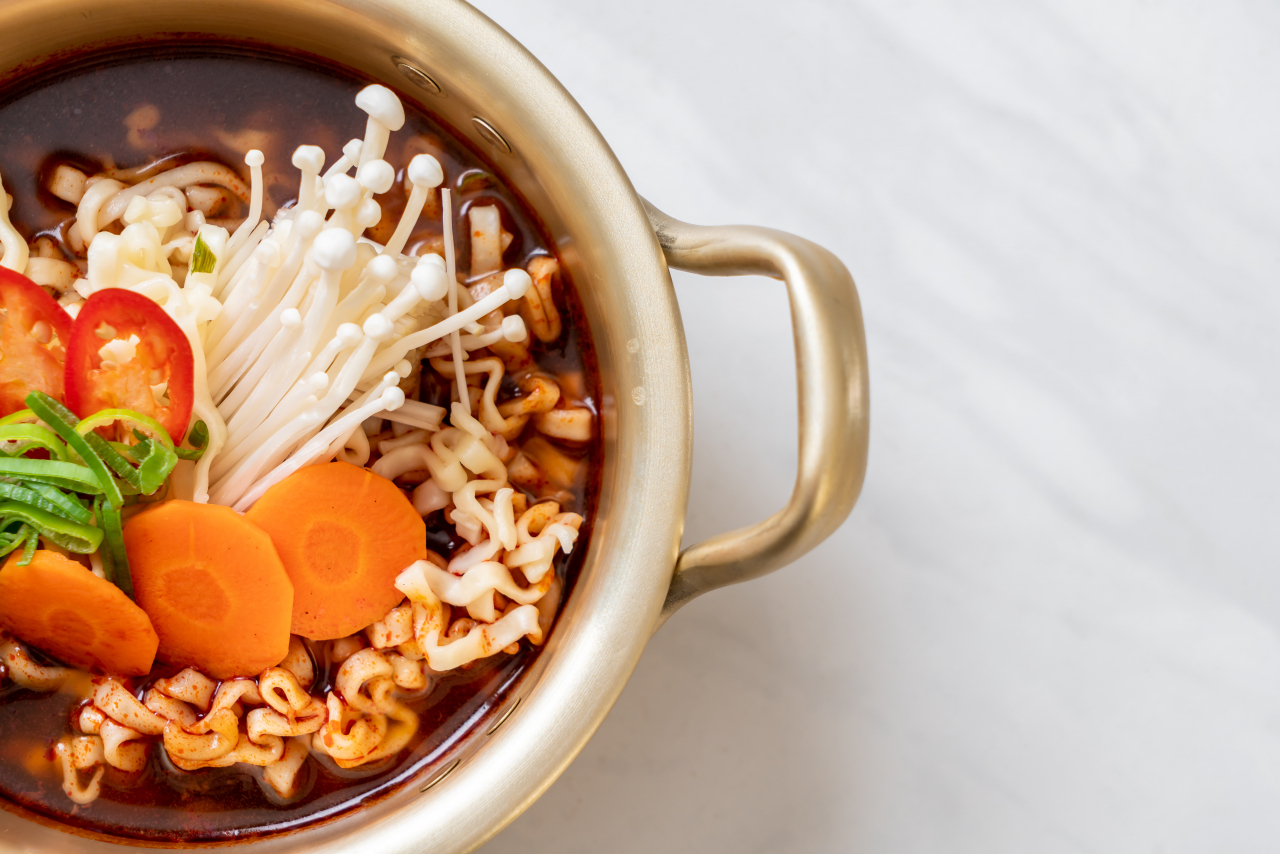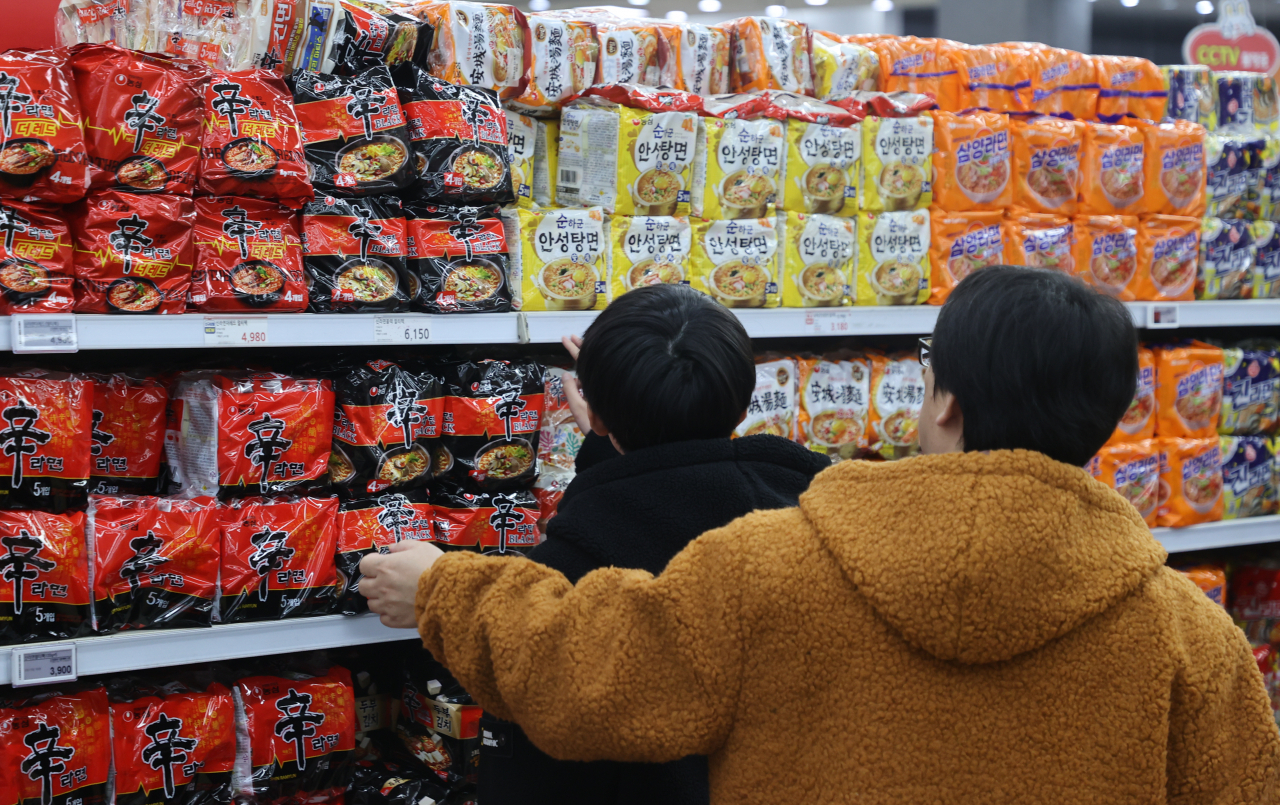Five facts about Korea's spicy affair with ramyeon
Beyond a cheap go-to meal, ramyeon has become a cultural icon, inspiring everything from film lines to international cravings
By Song Seung-hyunPublished : Dec. 19, 2023 - 17:31

Korean ramyeon holds a special place in Koreans’ hearts, not just their stomachs.
The iconic phrase, "Do you want to join me for some ramyeon (at my place)?" -- playfully employed in the 2001 film "One Fine Spring Day" to extend a late-night invitation to a romantic interest -- speaks volumes about its place in the Korean psyche.
Affordable, simple to make and scrumptious, ramyeon is without doubt many Koreans' soul food.
From its birth some 60 years ago to the latest trends and global foray, here are some interesting facts about Korean ramyeon.
1. Koreans consume 77 servings of instant noodles per year
According to 2022 data compiled by the World Instant Noodle Association, South Koreans consumed an average 77 servings of instant noodles per year. This translates into one bowl every 4.8 days.
The Vietnamese were the biggest noodle lovers with 83 servings last year, retaining the top spot for a second year.
Before being overtaken by the Southeast Asian nation in 2021, Korea was the title holder for years.
2. Spicy ramyeon was a presidential idea
Spicy noodles are the most popular type in South Korea now, but in ramyeon’s early days, the dish was mild, missing the spice factor.
Red chili powder’s mighty presence was popularized by former President Park Chung-hee, who in 1966 suggested adding the spicy powder to the broth to the country’s first ramyeon maker, Samyang Foods.
In 1963, Samyang introduced the first Korean ramyeon, Samyang Ramen, inspired by the concept of dehydrated noodles in Japan. The first product, sold at 10 won per packet -- which in 2023 roughly equates to about 630 won ($0.49) -- was wheat noodles in a mild chicken broth.
At the time, noodles in general were not a popular meal option, largely due to the longstanding preference for rice.
However, ramyeon’s fortunes took a turn in 1965 when the South Korean government, responding to a rice shortage, actively promoted the consumption of wheat flour. This was why Park, a military dictator who ruled the country for 16 years, thought of adapting ramyeon to better suit local tastes.
Decades later in the early 2010s, Samyang Foods would create another product that lifted the fortunes of Korean ramyeon as a whole once again -- Buldak Ramyeon, more widely known as "fire noodles" for its extra spicyness.
3. '80s was the golden era of ramyeon in Korea
The governmental push for wheat consumption played a crucial role in boosting the sales of instant noodles.
The '80s are remembered as the golden era of ramyeon in Korea, with iconic products such as Shin Ramyun, Paldo Bibimmyeon, Ansungtangmyun and Jjapaghetti all debuting during this period.
A typical packet of ramyeon cost 100 won at the time, a meal that was affordable to even those with little financial means.
The 1986 Asian Games three-time track gold medalist Lim Choon-ae, who came from a modest background, earned the nickname “the ramyeon girl” after she said in an interview, “I ate ramyeon every day and ran.”
Korean instant noodles may be experiencing its second heyday, as its popularity soars globally.
This year in particular marked a significant milestone, with annual exports reaching 1 trillion won for the first time.
According to data from the Korea Customs Service, ramyeon exports totaled $785.25 million in the first 10 months of the year, showcasing a 24.7 percent on-year increase. This figure has already surpassed the total exports of $765.41 million from 2022.
It is anticipated that the nation's ramyeon sales in overseas markets, encompassing both exports and direct sales, will surpass 2 trillion won this year. Direct sales refer to the sales of several Korean firms that are now producing ramyeon at overseas plants.

4. There are over 550 different ramyeon products in South Korea
South Korea currently boasts an estimated 550 different instant noodle products. This extensive variety, while affirming the Korean fondness for ramyeon, also reflects a diversification of the market.
When asked about the recent trends in ramyeon, an official from South Korea's top instant noodle maker Nongshim mentioned the challenge of singling out one trend, given its broad range of products and 60-plus-year history.
“However, we see a trend toward extremely spicy and fried instant noodles gaining popularity,” he said. “Additionally, spin-offs of existing brands have also become popular recently,” the official added.
As an example, he highlighted Nongshim's new Ansungtangmyun spin-off, which registers at zero on the Scoville scale, signifying its absence of spiciness.
This unique spin-off caters to foreign customers who may have a low spice tolerance and would prefer a milder alternative, he added.
Additionally, there is a growing demand for ramyeon offerings that claim to be comparatively healthier.
"I prefer non-fried instant noodles because they make me feel less guilty about eating them while on a diet," said Lee Hyun-jin, 32, an office worker.
Nongshim's non-fried ramyeon products, leading the non-fried noodle trend, achieved an annual sales milestone of over 100 billion won last year. Additionally, Nongshim's cumulative sales of non-fried noodles for the current year reached 78 billion won, reflecting a 40 percent on-year increase.
Lee also mentioned that she occasionally opts for instant cup noodles that substitute wheat noodles with glass noodles, considering them a smart choice for those hoping to lose weight.
5. Ramyeon is often an exception to the pricing rules
Due to its position as an affordable meal, any price hikes in ramyeon are a national issue. Now, a typical ramyeon product carries a price tag of around 1,000 won per packet.
In June, amid worries over the runaway inflation, Finance Minister Choo Kyung-ho made a not-so-subtle recommendation, suggesting that "with the drop in international wheat prices, it would be desirable to lower the price of ramyeon."
In response, some local companies made slight reductions in the prices of certain products.
Nongshim lowered the price of Shin Ramyun by 50 won, and Ottogi reduced the prices of 15 products, excluding Jin Ramyeon, by an average of 5 percent.
Samyang Foods also decreased the prices of 12 ramyeon products, accounting for 60 percent of the company’s ramyeon sales, by an average of 4.7 percent. The reduction did not apply to Samyang Foods' Buldak series.
These adjustments were reflected in convenience store prices, with popular products like Shin Ramyun now priced at 950 won and Samyang Ramen at 910 won per packet.
However, premium players such as Harim and Pulmuone opted not to participate in this round of price adjustments. They argued that their offered price has remained unchanged since their products' launch, as it had a different targeting approach from the start compared to conventional Korean ramyeon.
Harim's premium instant noodles, such as Jangin Ramen and Cham Ramen, are sold for 2,200 won and 3,800 won per packet, respectively.
Pulmuone offers various premium ramyeon products, including Tonkotsu Ramen at four packs for 5,480 won and Jjajang Ramen at four packs for 4,980 won, among others.



















![[Today’s K-pop] Treasure to publish magazine for debut anniversary](http://res.heraldm.com/phpwas/restmb_idxmake.php?idx=642&simg=/content/image/2024/07/26/20240726050551_0.jpg&u=)